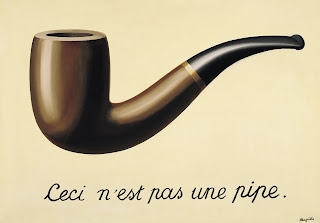
We were discussing semiotics in my art history class, and (of course) Magritte's The Treachery of Images came up, which got me thinking about Georgia O'Keeffe. There is no denying that many of O'Keeffe's paintings (particularly the flowers) resemble female genitalia, something that she denied consistently throughout her lifetime. This always seemed silly to me, especially knowing what little I do about O'Keeffe and her interest in gender (for more on this read Susan Fillin-Yeh's Dandies, Marginality and Modernism: Georgia O'Keeffe, Marcel Duchamp and other Cross-dressers). The paintings are in my mind clearly genitalia and the idea of this being coincidence or a result of my own mind is just absurd. But in came Magritte, "Ceci n'est pas une pipe". This is not a pipe.
Magritte was perhaps playing with different questions (signified vs. signifier, what is "a pipe"), but his contrary statement is perhaps equivalent to O'Keeffe's in that the intent is to allow for thought. By invariably insisting that her paintings were flowers and that was all, or abstract and that was all, O'Keeffe was essentially saying "This is not a labia". If we are to take her for her word, we then must wonder why we are seeing it that way. Are we really so sexually minded that we cannot look at an innocent painting of nature without seeing genitals?
Let's just say (for the sake of my theory) that O'Keeffe was painting vulvas. This is what most people see when they look at them. If O'Keeffe was to agree- that these are vulvas and that this is what she was painting, the conversation ends. 'O'Keeffe is a weird feminist painting weird, obviously vaginal flowers. We were right. Moving on'. But by denying this, the paintings become weirdly voyeuristic, we are forced to think about our own perception.
I'm not sure people give her enough credit. She wasn't unaware what she was doing, either in painting or in the way that she approached or discussed her paintings publicly.



images: Magritte, O'Keeffe & Alfred Stieglitz (photograph of O'Keeffe)

No comments:
Post a Comment